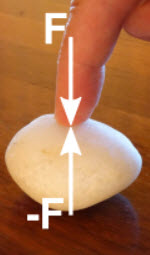Newton's Laws of Motion
Please read Force first.

Newton's Three Laws
Back in 1687 Sir Isaac Newton wrote three laws about motion, which basically are:
- 1st Law: Force is needed to change an object's velocity
- 2nd Law: F = ma
- 3rd Law: Every action has an equal and opposite reaction
They have wide use today (unless we are dealing with speeds close to the speed of light, or very small things like atoms).
Newton's First Law (Law of Inertia)
Newton originally wrote (translated from Latin):
Since "state of rest" is simply zero velocity we can more simply say:
In the absence of any external forces, an object will keep doing whatever it was doing.
This is the idea of inertia: matter resists change in its state of motion.
So why do things tend to slow down? Friction!
Friction is a force that opposes current motion. There is so much friction in the world that everything we experience tends to slow down.
But in space things just naturally drift along.
Newton's Second Law (Law of Acceleration)
Replacing "change of motion" with acceleration creates this very simple idea:
In fact they are linked by mass: when there is more "stuff" to be accelerated it is harder to get it all moving.
And so we get the most useful equation in all of engineering:
Force equals mass times acceleration.
The greater the force applied the greater the acceleration, but greater mass causes less acceleration. See Force for more details.
Example: Elevator Ride
You are in a free-running elevator held up by a counterweight on a pulley.
- You and the elevator together weigh 150kg
- The counterweight is 125kg
Are you in danger? What will your acceleration be?
Let's start with F = ma
We want to know acceleration so let's rearrange that into:
a = Fm
The total mass that is being accelerated is 150 kg + 125 kg = 275 kg
The force, though, is created only by the difference between weights:
Weight difference = 150 kg − 125 kg = 25 kg
With gravity (g=9.8 m/s2) that makes a force of:
Force = 25 kg × 9.8 m/s2 = 245 N
Let's plug our values in!
a = Fm = 245 N275 kg = 0.89 m/s2
So less than a tenth of gravity's acceleration, just don't fall too far!
(What if the weight was 160 kg?, or 200 kg?)
For more examples see Force Calculations.
Momentum
Why did Newton not include mass in his law? Perhaps by "motion" he meant momentum.
Momentum (p) is an object's mass (m) times its velocity (v): p = mv.
So maybe this is a better rephrasing:
Which can be written:
The "Δ" means "change in", so it says the force is equal to the change in momentum over time.
Both F = ΔpΔt and F = ma are useful! Read momentum to see how they relate.
Newton's Third Law (Law of Action and Reaction)

Which is usually rephrased as:
Examples:
- If you press a stone with your finger, the finger is also pressed by the stone.
- A rocket propels itself forward by ejecting gases in the opposite direction
- a swimmer moves through the water by pushing against it with their arms and legs, and the water in turn pushes them forward